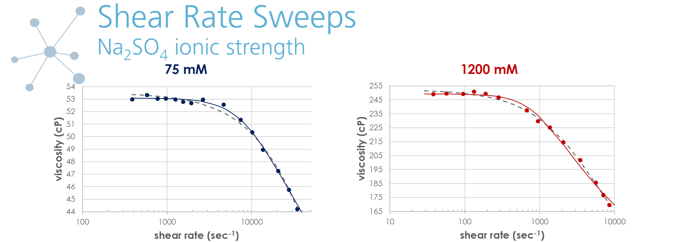We have mentioned in our previous blog the advantages of a thorough multi-point viscosity analysis that includes both shear rate and temperature variation. This data can be used for performance prediction, and can also be utilized to investigate the component interactions.
Common multi-point viscosity measurements include:
- Shear rate sweeps: determine the impact of shear strength on a sample’s microstructure
- Temperature sweeps: determine the viscosity at all temperatures relevant to preparation, storage, processing, and delivery
- Concentrations: focus on the dilute regime to measure size and interactions between molecules
- Scaling Analysis: extracts relevant solution parameters, such as cluster size to rank formulations
Shear rate sweeps offer the opportunity to extract more detailed information about formulation components and microstructure, specifically to determine the onset of non-Newtonian behavior and assess the correlation of increased cluster size with increased plateau viscosity. Even a simple qualitative interpretation can be used to guide formulation development.

Temperature has a huge impact on viscosity. Water is a good example of this impact. When it gets colder, it starts to freeze and when it gets warmer, it starts to slowly boil. Every fluid sample has it's own characteristics and can display variations at different temperatures including temporary or permanent alteration of the sample. Most solutions will experience a broad range of temperatures from cold storage to room, or body, temperature or even higher if heating is part of use or delivery. Therefore, measuring viscosity at multiple temperatures relevant to the formulation process, manufacturing, storage, and delivery is critical to predict the ability to handle or process under all relevant conditions.

Download our eBook to learn more about multi-point viscosity measurements of proteins!
RheoSense offers a variety of viscometers that measure viscosity under high-throughput capabilities under various shear rates. Your research and criteria is a uniquely tailored application, which is why our team works closely with you to determine which VROC® instrument is right for you! Talk to one of our specialists today to determine what multi-point measurements, and VROC viscometer, will fit best with your applications. 
Written by: Eden Reid, RheoSense Senior Marketing & Sales Operations


